To understand how this all works, let's start with the sun. On January 31st a massive coronal hole opened up on the sun, hurling another sledgehammer of charged particles in the direction of Earth. This was due to impact us sometime between February 2nd and February 4th. Not only this, but we recently passed through a new Moon on February 2nd. But why is the Moon of any significance here, one might ask?
As James McCanney explains in an interview he did for Spectrum Magazine in 2003:
The [New] Moon moves in front of Earth, breaks that electrical flow [between the sun and Earth], and then moves out of the way. It gives us tremendous bombardment after that Moon moves out of the way, the first and second day after the New Moon. That's the condition that has been identified as being one of the leading causes of kicking-off major hurricanes and storms. What it does is: The Moon is interacting with the solar electric field. It's that CHANGE which causes the storms, and causes the environment around Earth to change, and thus affects Earth weather.So the picture we're painting is this: The sun blasts a massive front of solar wind in the direction of the Earth. As the New Moon moves out of the way of the sun and Earth, this, by itself, creates a significant increase in charged particles hitting the Earth. With the excess of charged particles from this solar storm hitting us near simultaneously, all of this excess charge ends up in the radiation belts surrounding the Earth. The Earth then finds ways to discharge this imbalance such as these two major storms we've seen. One storm takes the form of a massive blizzard covering about half of the US. The other takes the form of a cyclone storm, Yasi, that pounds the already flooded east coast of Australia. Increased volcanic and earthquake activity was also noted during this time as well.
For those who don't think that a blizzard could possibly have any significant electrical discharge effects, check out this video of lightning over the Chicago area while in the midst of the blizzard's grip:
So from this one example, it seem that there may be a correlation between certain activity in space and chaos on Earth, and that the primary means of this "action at a distance" is through electrical interactions. This is the hypothesis put forth by James McCanney whose theories were featured in my last article Pole Shift... The big question is: Is this hypothesis correct? Does space weather really affect us here on Earth? We're told by mainstream science that events such as electric storms, blizzards, hurricanes, cyclones, earthquakes, volcanoes and many other displays of nature's fury are only caused by forces internal to the Earth itself; that we are insulated in a tight atmospheric bubble that exists in a void of near empty space. In contrast, McCanney postulates that we are at the mercy of powerful electric forces in space and that these do play a role in the many energetic events on Earth. So who is right?
Before we can answer that, we need to clear up some confusion on what might be the real forces behind events like lightning storms, cyclones, volcanoes and earthquakes. It turns out all of this phenomena might be of secondary origin to the Earth attempting to discharge electricity from space; these events may be part of the Earth's natural grounding process.
Lightning: "Bolts From Space"
Lightning, from our perspective, is obviously a discharge of electricity to the ground from clouds sitting in the troposphere (the lowest and densest atmospheric layer). The mainstream hypothesis of how lightning is produced from clouds goes something like this:
In the process of the water cycle, moisture can accumulate in the atmosphere. This accumulation is what we see as a cloud. Interestingly, clouds can contain millions upon millions of water droplets and ice suspended in the air. As the process of evaporation and condensation continues, these droplets collide with other moisture that is in the process of condensing as it rises. Also, the rising moisture may collide with ice or sleet that is in the process of falling to the earth or located in the lower portion of the cloud. The importance of these collisions is that electrons are knocked off of the rising moisture, thus creating a charge separation.This is the electrostatic induction hypothesis (EIH) of how lightning forms, in a nutshell. There are other similar hypotheses that center on clouds as the producers of lightning, but the EIH is the one generally taught to school children. Keep in mind this is only a hypothesis, nobody has ever come up with an experiment to prove or disprove it yet. This one is still "under investigation" according to most outlets of science knowledge.
The problem with this hypothesis is that the energy involved with lightning is simply enormous. It is well known that there are on average 100 lightning strikes around the globe per second. The average lightning bolt discharges an energy of about 500 megajoules in a strike - by conservative estimates. This amounts to 50 gigajoules of energy discharged to the ground per second! This writer finds it difficult to believe that the method proposed by the EIH can produce energies of this magnitude. It seems likely that the power source of lightning is coming from somewhere else.
Since our perspective is usually looking up at the sky during a thunderstorm, we may be missing what goes on above the clouds. As it turns out, a lot goes on above clouds during a thunderstorm in terms of lightning. None of this we would necessarily see on the ground, however.
Above-cloud lightning comes in two main forms called jets and sprites. Jets appear to shoot straight up in either red or blue colors, often touching the lower boundary of the ionosphere - that protective layer of plasma that we use to bounce AM radio signals off of. Sprites are another form of lightning, only these don't come from out of cloud tops, but from out of the ionosphere high above. They appear as massively glowing holes with filaments stretching down for miles (see image below). Once thought to be quite rare, it is now known that sprites are a common, everyday occurrence around the globe in conjunction with electrical storms.
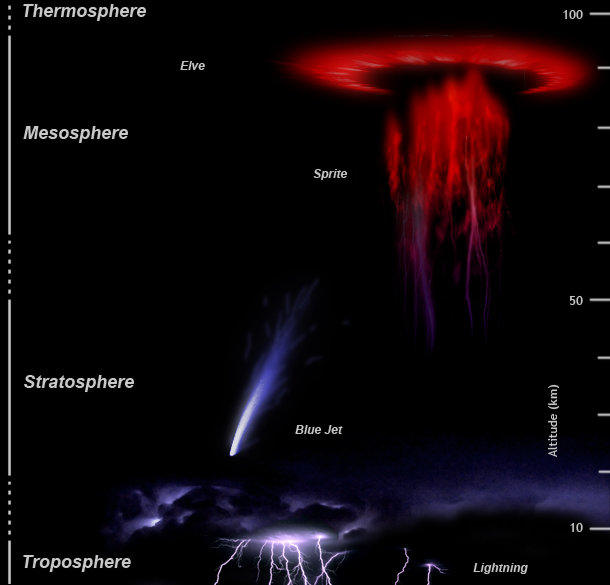
Interestingly, there appears to be a correlation between positive lightning and the sprites mentioned above that dangle down from the ionosphere. Investigators soon "realized that every time there was a sprite above the clouds there was a bolt of positive lightning below the clouds. The sprite and the positive bolt were parts of a single discharge that stretched from space to the Earth's surface."
These bolts of positive lightning are quite literally "bolts from space". The combination of sprites and positive lightning form a massive dielectric breakdown in the atmosphere, passing electrical energy from the ionosphere to the ground. With this comprehension, the "electrostatic induction hypothesis" is simply absurd. The main source of energy for thunderstorms, and likely other storm systems, appears to come from outside of the Earth.
Cyclones: Another Electromagnetic Wonder
In addition to lightning, cyclone storms are another suspected means of discharging electrical charge brought in from space. By cyclone storms, I mean anything from hurricanes, cyclones, typhoons, tornadoes, or anything that forms a funnel shaped cloud over land or water. According to McCanney and others such as Walter Thornhill, these cyclones may be attempts to move charge quickly from the lower atmosphere to the ground. As Thornhill writes on the topic of tornadoes:
Meteorologists are not sure how tornadoes form but they do know that they are often associated with severe electrical storms. The key to understanding tornadoes is that they are the result of rapidly rotating electric charge. Just as electrons are the current carriers in the copper wires we use for power transmission, so they are in the tornado. The BIG difference is that the electrons are moving at many metres per second in the tornado while they take several hours to move one metre in copper wire! The result is that enormously powerful electromagnetic forces are in control of the tornado.This means that instead of counter-rotating wind currents holding the tornado together, the wind is actually an effect of rotating electric charge sheets. The scientists studying tornadoes might have everything backwards. Seeing as tornadoes may be electrical in nature, we might expect to see electrical anomalies in and around the tornadoes themselves. In a paper by A.N. Dmitriev titled Electrogravidynamic Concept of Tornadoes, he expounds a litany of strange anomalies associated with tornadoes:
In 1951 in Texas a funnel passed over an observer at 6 meter height, the interior having diameter about 130m with walls of 3 meter width. Inside the hollow there was a brilliant cloud. There was no vacuum inside, because it was easy to breath . The walls were rotating with a very high speed, and the rotation might be seen up to the top of the column. A bit later the funnel touched the neighbor's house and immediately took it off. This description is similar to many others [Fl, Jus, Ho] and require the explanation of the fact that rotation of the air necessarily leads to decrease of pressure. Why, being 6m above the ground, the funnel end causes neither damage nor intense air motion, while, upon touching the ground, destroys and moves off a house?While one would be hard pressed to explain all of these strange happenings in terms of a new electric theory of tornadoes (unless that theory included new facets of electromagnetism itself), there is certainly an element of electrical activity in some of these anomalies. Light effects, ball lightning, buzzing and hissing sounds are all properties of electricity in some form.
[...]
A funnel uprooted the apple tree, tearing it to pieces. A beehive standing a couple of meters from it was left safe.[Hay] A two-story timber house was taken off with its inhabitants and torn to pieces. A staircase of three stairs led to the door with a bench leaning against it. Both, bench and staircase were not moved. The funnel also torn off two wheels of a car standing by, not moving the car itself, while an oil lamp which stood near on a table under a tree, still kept burning. [Fin].
[...]
The ability of objects to penetrate the other ones is also being referred to high rotation speeds. A small pebble punctures a glass like a bullet without forming fractures. One board penetrates the other without shattering it. A timber house wall is found punctured by an old charred plank, with it's porous tip staying undamaged. A clover leaf was found pressed into a hard stucco wall. A 1.5 inches gate frame was found punctured by a piece of wood. [La, Graz].
Crossing a river, a funnel pulls up such a quantity of water that it uncovers the river bed, forming a trench in the water. Such phenomena were seen on the Mississippi and Moscow rivers. On the Rhine river, where the depth was 25m, the trench was 7 meters deep. [Nal]
Tornadoes may lift and transport people and animals at 4-10 km distances, sometimes keeping them alive. One inch mollusks were moved 160 km [ La], but fell upon the ground one hour before the cloud's coming. On June 17,1940 in Meschery village of the Gorky region in Russia, a tornado poured out about a thousand XIV century silver coins. The coins were falling from the cloud, but not from the funnel itself. The treasure was transported for several kilometers and was then poured out over a compact area. [Nal]
[...]
A large timber church with 50 people in it was moved 6 meters; no one was killed. In 1963 a funnel transported a house with 10 inhabitants at 400 m distance; all stayed alive. [Nal]
The funnel, when it's not touching the ground, emits a buzzing or hissing noise. Faye [Fa] describes several cases when the tornado was accompanied by ball lightning. Sometimes short and wide sheet lightning surround a funnel. Sometime all the surface of a funnel shines a strange yellow glow. Sometimes observers describe a bluish ball-like formation like ball lightning, but much larger, visible in a cloud. Sometimes slowly moving fire columns are seen. [VoM, Vo60,Fr ] Jones describes a pulse generator - some center of electric activity looking as a round, bright, blue spot in a parent cloud, appearing 30-90 minutes before a funnel. [Jo]
When it comes to hurricanes or other cyclone storms that form over water, mainstream science hypothesizes a completely different set of principles governing their formation than the ones used for tornado formation. In fact, when it comes to cyclones, there are even different formation theories depending on where on Earth the cyclone forms! I'm not going to go into the details of these theories because they are well known and can be found elsewhere. However, doesn't it seem odd that such similar storm systems found in nature could have entirely different causes? From a phenomenological standpoint both cyclones and tornadoes form funnel shaped clouds, but the main difference between tornadoes and cyclones is the duration in which they persist and, of course, where they form (over land or water). Hurricanes or cyclones also tend to lose strength after making landfall. According to McCanney:
... [T]he reason hurricanes lost power when they approached land was that the powering electrical current from the ionosphere to the cloud tops and to the Earth's surface had no connection (anode) while over the ocean ... so it drew up vast surface areas of ionized air from the ocean surface and sucked them up a central column (the spinning vortex was caused by the moist air rising "up the drain")... whereas the land provided a "ground" for the current and therefore it shunted out the storm's power source.So the hypothetical reason why cyclones get so large and last for so long is because the ocean acts as an electrical insulator, preventing charge from reaching the more conductive terra firma on the ocean floor beneath. This explains why tornadoes don't last nearly as long: they are already over land which allows them to discharge faster. In other words, the phenomena of cyclones and tornadoes are really of the same electromagnetic origin, but the surface conditions over where they form give them their unique properties.
[McCanney 2002 p 71]
As we've seen from recent events, by monitoring the conditions on the sun, and noting the alignments of planetary objects (including moons and even comets), we can predict when the Earth may receive a sudden electric jolt that could result in more cyclone storm activity. On his website, McCanney lists a number of correlations where solar activity and cosmic alignments precipitated into massive storms on Earth. One such instance occurred in September of 2004 when two hurricanes formed out of the Atlantic Ocean and several others formed in the Pacific Ocean (see image below). According to McCanney this explosion of cyclone storms was preceded by solar storms and happened the day after a New Moon. Does any of this sound familiar?
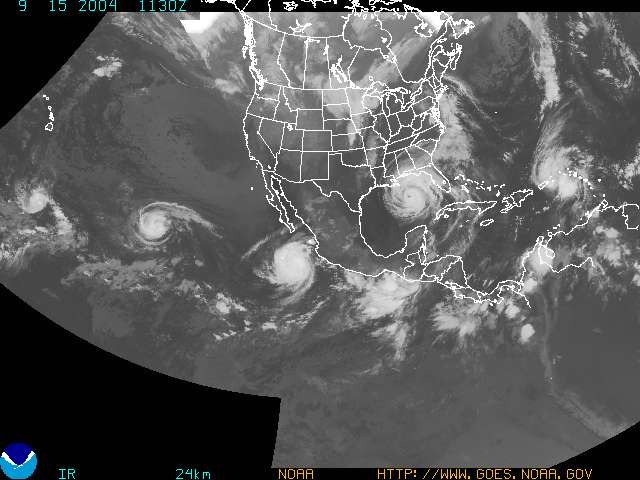
In the 1990s NASA developed a satellite known as a Lightning Imaging Sensor in order to calculate the number of upper atmosphere lightning strikes in a storm. These lightning strikes, invisible to the naked eye because of dense cloud cover, are thought to be early predictors of tornadic activity. As the lightening increases, the likelihood of a tornado increases.This implies that even those predicting tornadoes now are using signposts of electrical activity to make their predictions. Even with this new technique of detection, they still haven't put two and two together when it comes to the electrical nature of the tornadoes themselves.
Transdimensional Weather?
To add some food for thought to this topic, I thought I would mention one more possible connection. Anomalies involving tornadoes were mentioned above in Dmitriev's paper, but do any strange anomalies exist for hurricanes and cyclones? Since they happen over water we don't share much of an intimate relation with these storms until they make landfall, so our data set is rather limited. However, as it turns out "tropical cyclone basins" (those areas where cyclones are likely to form) have an uncanny relationship to plane and ship disappearances described in the Fortean literature. Now, I know you're probably thinking: "Duh, of course! A cyclone would swallow up any plane or ship." Unfortunately, it isn't that simple.
The so-called Bermuda "Triangle" is one such location where these disappearances are noted. This area coincides with the tropical cyclone basin in the North Atlantic where hurricanes usually pick up steam before impacting the US, Caribbean or Mexico. According to the late Ivan T. Sanderson, zoologist and ufologist, in his book Invisible Residents, the Bermuda Triangle isn't really a 'triangle', per say. It actually forms more of a lozenge blob and it extends much further east than what people believe. Furthermore, there are a number of similar locations around the globe where planes and ships seem to have a higher than average probability of disappearing. All of these areas form around the 30-40 degree latitude mark that coincides with the sub-tropical jet streams, which according to McCanney, are large sheets of rotating charge forming part of the Earth's impermanent magnetic field.
Now by planes or ships disappearing, I don't mean just sinking or falling into the ocean. The stories Sanderson relates about these disappearances showed that there were few signs of the ships or planes to be found. In many of these cases there was no sign of damage, no floating cargo, no oil sheen from leaked fuel, nothing that would indicate destruction of any sort. Many of these disappearances happened under clear skies and in calm waters too. UFO sightings are not uncommon in these regions as well. Sanderson lists many such cases in his book.
When Sanderson started to plot out the areas where such disappearances occurred, he noticed that they began to fall into a regular pattern. With further research and the help of geologists and mathematicians, he was able to plot a hypothetical grid - based on principals of geometric symmetry - where such strange events were likely to occur. This "vile vortices" grid (displayed below) shows the result of extrapolating the pattern of disappearances to the entire globe. Sanderson was limited by what data on plane and ship disappearances he could find, which included only a couple hundred good cases, by his account. Not only this, but the notion that these "vile vortices" line up with perfect symmetry across the globe may be an incorrect assumption on Sanderson's part. For instance, the numbered area labeled "20" on the map below, situated in North Africa, should really be closer to the eastern Mediterranean according to Sanderson's research into the actual disappearances. Interestingly, cyclone type storms have, on rare occasion, formed in this region of the Mediterranean Sea.
By comparing Sanderson's "vile vortex" grid to the "tropical cyclone basin" map, there seems to be a parallel, although it is not exact. This is probably due to reasons I mentioned in the paragraph above. Also note that the "vortex" region numbered "49" off the east coast of South America has occasionally produced cyclone storms, although this is not generally considered a tropical cyclone basin.
Could the electrical forces that feed cyclones also be the cause of these strange plane and ship disappearances at odd times? I'll let the reader decide on this one. Perhaps someday in the future we will have to develop a transdimensional weather alert system? Hmm...
Earthquakes and Volcanoes Too?
Yes, I'm afraid so. Both Earthquakes and Volcanoes exhibit much electrical activity as well. It is well known that lightning is a common element around volcano eruptions. As Walter Thornhill describes:
More than 150 times in the past two centuries, volcanic eruptions have been accompanied by spectacular displays of lightning. Sometimes broad bolts of lightning streak across the sky. Other times St. Elmo's fire (ball lightning) cascades from above. Sometimes volcanoes produce branching displays such as at Sakurajima ... The 1981 eruption of Mt St Helens featured a spectacular display of sheet lightning, with truck-sized balls of St Elmo's fire seen rolling along the ground 29 miles north of the mountain. Other well-known volcanoes that produced lightning include Vesuvius (1944), Krakatau (1990's), Surtsey, the new volcanic island in Iceland (1963), and Paracutin, the cinder cone that grew out of a farmer's field in Mexico (1940's.)As expected, the commonly accepted hypothesis explaining why lightning occurs around volcanoes has to do with volcanic dust colliding and separating charge. This is largely a spin-off of the "electrostatic induction hypothesis" as we've covered above. Given what we know about lightning now, this hypothesis seems unlikely. For example, why does it appear in some pictures - like one from the recent volcanic eruption of Mount Kirishima in Japan - that the lightning actually comes out of the volcano top at certain times? Perhaps electromagnetic forces are part of the underlying cause behind volcano eruptions? More research is definitely needed in this area.
Just to note, Mount Kirishima, as pictured above, experienced a series of three eruptions on February 3rd which coincides with our major storms mentioned in the introduction. Volcanoes around the globe are waking up. We may be in for a rocky, ash-filled ride.
"Earthquake lights" are not an uncommon scene before, during, and immediately after earthquakes. Up until recently, the existence of these lights was denied by mainstream scientists who regarded them as some form of mass delusion. However, pictures from the Matsushiro earthquake swarm in Nagano, Japan, from 1965 through 1967, show that they are a genuine phenomena of nature. Perhaps these lights have something to do with electrical discharges taking place over or through these seismic zones? Like cyclone storms and volcanoes, earthquakes too seem to have a greater probability of occurring after solar activity and during or immediately after planetary alignments.
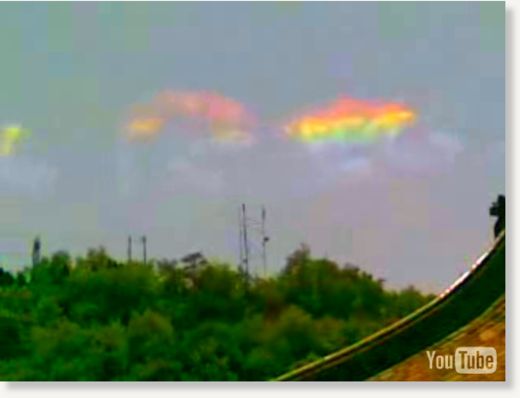
Now, I'm sure those of skeptical mind are probably saying, "So what? Don't earthquakes happen every day?" That is true, but one must take into consideration all the other factors we've noted above which also discharge the planet: events such as lightning storms, cyclones, tornadoes, hurricanes, etc. Once we factor in all of these discharging events, maybe then we will begin to see the overall patterns. Any of these events taken in isolation show us nothing, but when brought together there seems to be a correlation - as recent events show. Every massively energetic event that happens on the surface of this planet is likely the result of activity in our solar system along with the Earth's attempt to correct any electrical imbalances from such. As Dmitriev writes:
The facts of various luminescences in the atmosphere were known long ago: preceding and accompanying earthquakes; preceding and accompanying volcanic eruptions; before and during the passage of tropical hurricanes; during a thunderstorm's development; and above the tectonic fault areas. Actually, there's no large-scale high-energy event in the depths of the Earth or on its surface which would not be accompanied by luminous objects. Without any reason or proof, these emitting atmospheric objects are considered as effects of the "main" events, i.e. earthquakes, hurricanes, eruptions, tornadoes, fault-developing processes, thunderstorms, etc. This version of secondary genesis of luminous objects and of their dependence of the main process keeps out of notice thousands of luminous [phenomena], existing in quiet atmospheric and lithospheric conditions.And this is largely the problem. Science considers the purely energetic, luminous, or electric effects as secondary to some main event that corresponds to something that we see, feel or experience in some manner. It would be like a prehistoric caveman seeing a person in our time flip a light switch and concluding that the motion or position of the switch is responsible for the flood of light in the room. Without any knowledge of the electrical power source behind the light, the interaction between the person, the switch, and the light is largely misunderstood. Perhaps we are still the cavemen when it comes to understanding these powerful energetic events on our planet? Without knowledge of the electrical forces from outside of Earth flipping the various switches on our planet causing thunderstorms, cyclones, volcanoes and earthquakes, etc., we miss the big picture.
And this is why here at SOTT.net we have a category dedicated to Earth Changes. As some readers may have noticed, we lump anything related to earthquakes, volcanoes, any sort of weather-related phenomena or atmospheric displays into this category. We also have a section called Fire in the Sky where we carry any sort of space weather news such as solar storms, comet sightings, NEOs, etc. While we don't consider ourselves in the business of predicting weather or natural disasters, we do keep track of the Signs. And if McCanney, Thornhill and others are correct, then watching events in space may give us a newfound understanding of the general ebb and flow of energetic forces that affect all of us. Understanding the electrical connections seems to be a big part of this.
So while we can't make any specific predictions with this knowledge, we can track the general exchange of cosmic electrical energy in our immediate environment. Human civilization is not exempt from this energy as the mass protests sweeping the Middle East can attest. This excess of electricity from the cosmos seems to translate into powerful emotional displays at the human level - both individually and collectively. There is no action without an equal and opposite reaction; this is true both in physics and esoterica. As this energy affects us all, the best we can do is to get ready by cleaning up our environment, our relationships, our minds, and our bodies by removing toxins of various forms so that we CAN transduce this energy into truly creative forms that won't lead us down the path of destruction. So while changes appear to be underway, we still have the choice of how to use this energy.
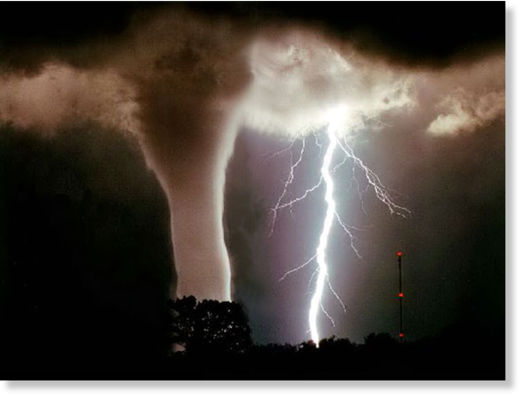
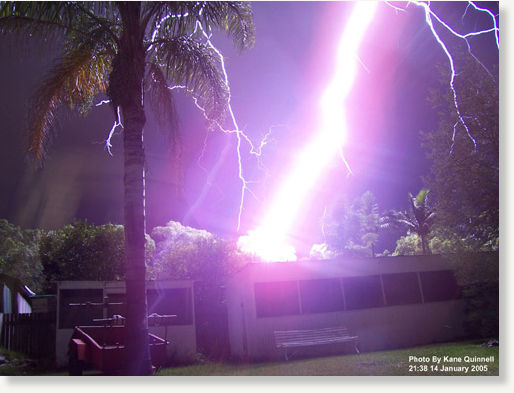

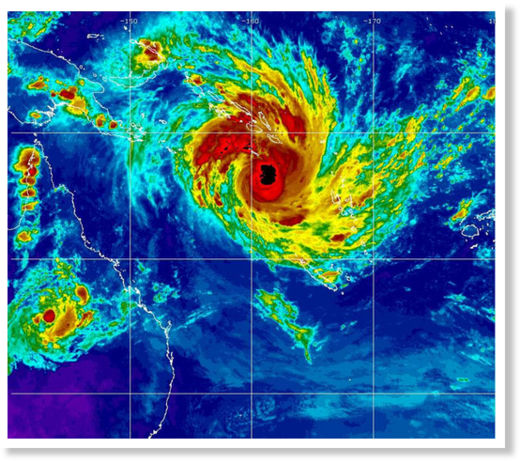
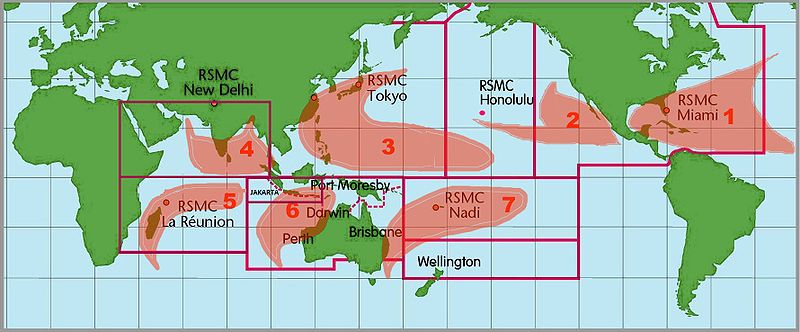
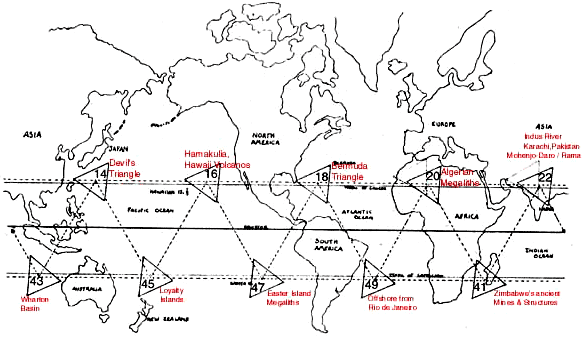
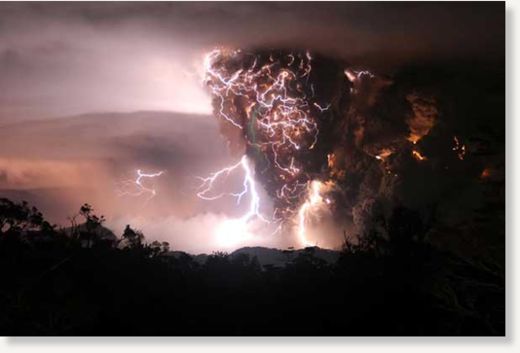
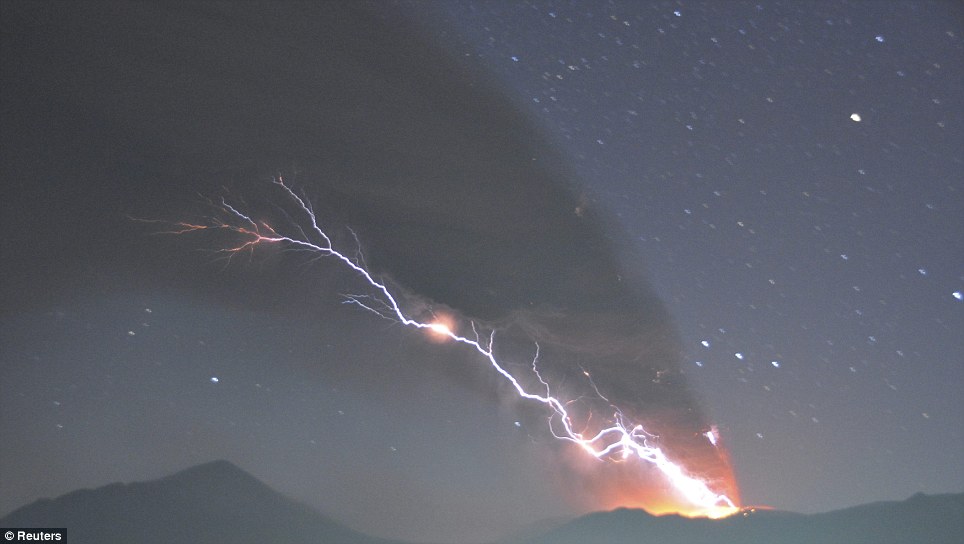
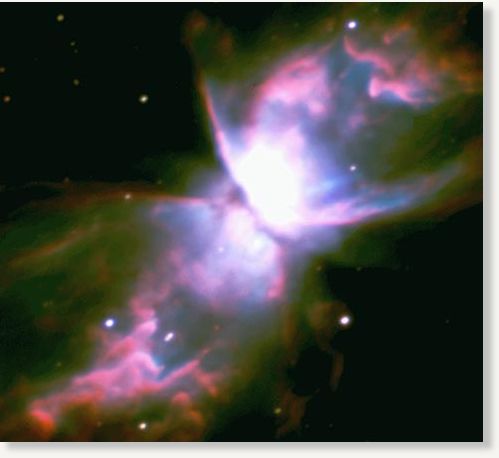



presentation...very logical and stimulating - I liked the last part about the events in north africa and the middle east...wasnt it stated somewhere about our evolution that we are affected by our environment and our environment is affected by us. That the overall effect is energy and that energy is the binding plasma that forms the solidity of matter and the events that occur as a result.